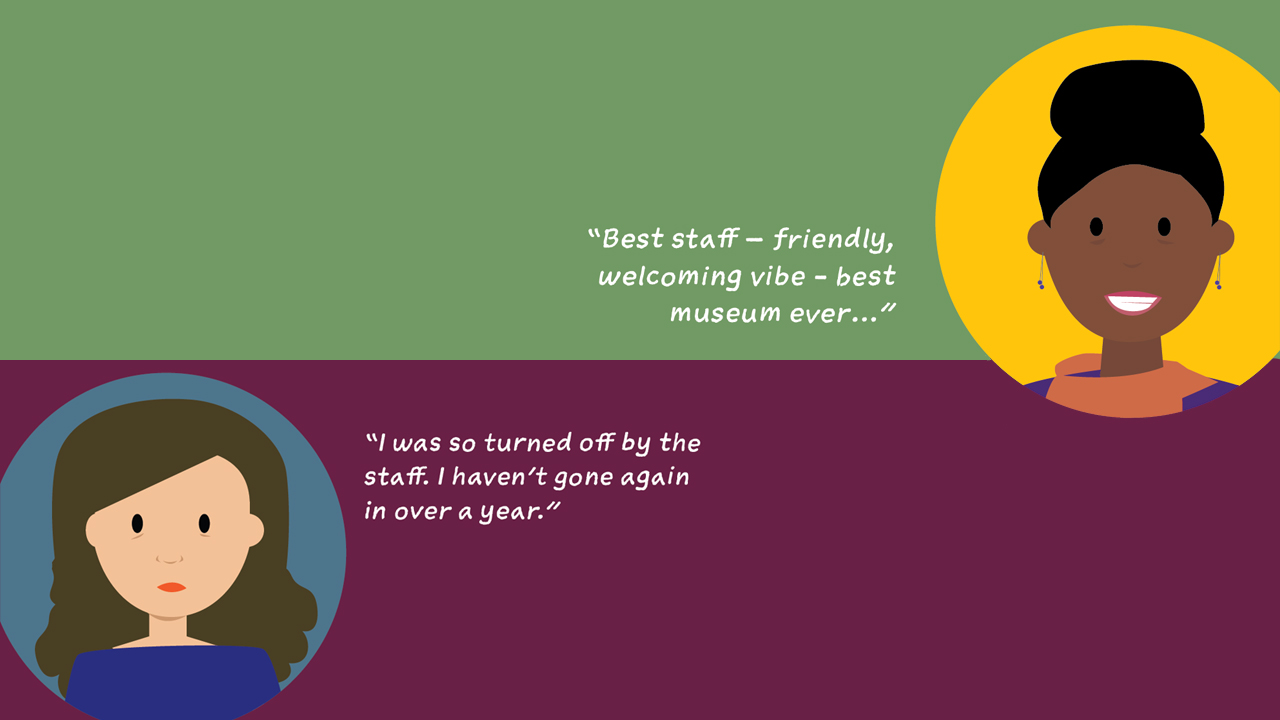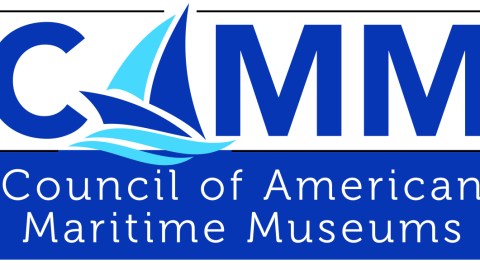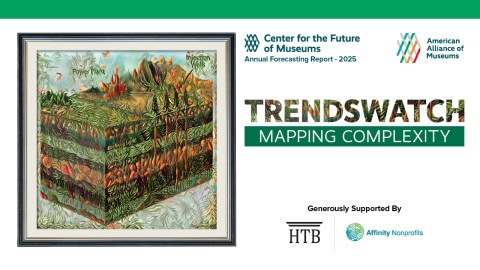
This visual Data Story is based on findings from the 2024 Annual Survey of Museum-Goers, a national survey of American museum visitors from AAM and Wilkening Consulting. Every year, the survey partners with individual museums to research their audiences and yield insights about their behaviors and preferences, both on an institutional and national level. Interested in joining the 2025 edition on the themes of repeat visitation, social connection, and community trust and responsibility? Sign up by February 28, 2025, for a special early bird rate.


While most people visit museums to learn, see amazing things, relax, and spend time with the people they care about, there is another aspect of visiting that can make or break a visit.
That is, an amazing exchange with staff can elevate an experience exponentially, but a negative experience can be ruinous. Because these interactions can affect museum experiences deeply, perspectives on staff deserve greater scrutiny.
To learn more about staff interactions, we looked at the results from the 2024 Annual Survey of Museum-Goers to sort respondents based on their answers. They fell into three categories:
- Staff is great! These respondents said that “staff members always make me feel welcome.” A third of respondents (33%) indicated this.
- Staff is a problem. These respondents indicated either they wanted “friendlier/ more welcoming staff” and/or that staff was “inattentive or rude.” Only 3% of respondents chose this.
- And nearly 2/3 (64%) of respondents didn’t weigh in at all…skipping over these staff-related answer choices.
Let’s now look at the differences amongst these respondents.
Staff is great!
“Best staff–friendly, welcoming vibe–best museum ever…”
“The staff members are always friendly, welcoming and engaging, and not just with the kids! As a parent, I feel welcome here each and every time we visit. A huge thank you to the staff for everything they do and the bright smiles they bring.”
The respondents who were complimentary about staff are super-engaged museum-goers. Compared to other respondents they:
- Visit far more frequently
- Are much more likely to visit to learn and to think museums are fun
- Identify as curious
- Are much more complimentary about exhibits and programs
- Are 2 – 3x more likely to think museums help people in the community
- Are 50% more likely to say museums contribute to the quality of life in the community
- Hold more inclusive attitudes
The question is: if we can increase satisfaction with staff through excellent visitor services, does overall engagement increase? Or are visitors who are delighted with museum content more likely to say staff is welcoming?
It’s a bit of a chicken-and-egg scenario, but if improving satisfaction with staff breaks more people into that virtuous cycle, this seems like an effective way of increasing engagement and visitation overall.
When it goes wrong…
“Every time I enter the museum, I get nervous because I get treated like a criminal smuggling in things, when in reality, I have a bottle and formula for my baby.”
“I was so turned off by the staff. I haven’t gone again in over a year.”
Respondents who wanted friendlier or more welcoming staff, or who said staff was inattentive or rude, were extremely unhappy with museums. While they are very few (only 3%), their extraordinarily negative feedback (and likely negative word-of-mouth) makes it worthwhile to stop and consider what’s happening here.
Interestingly, these respondents appear to care deeply about museums. They visit almost as frequently as those who felt staff was great, and they have similarly strong motivations to visit: they are actually the most likely to say they visit for their children’s learning experiences.
But something about the relationship has clearly gone wrong, and this comes out in their other negativity. Compared to those happy with staff they are:
- A whopping 29x more likely to say the museum they are responding to “doesn’t do anything well”
- 2.5x more likely to be critical of exhibitions
- 3x more likely to cite the high cost of visiting
- 3x more likely to say museums are “outdated”
- 70% more likely to hold anti-inclusive values
It is unclear if their dissatisfaction with staff is the cause or a symptom of a problem. That said, what are the scenarios that create tension between staff and visitors? Written-in responses give us some insight.
Some negative comments are concentrated in a few museums where there are clearly staff and/or leadership issues. In this case, the problem is with the museum and needs to be addressed internally.
Some may have been flashpoint incidents where better training of staff in customer service generally can be helpful so that these types of incidents are minimized or addressed properly.
A significant percentage, however, are coming from individuals who are less inclusive and/or more “resistant” to content that museums share. When they complain, they become even more embittered when their values are not validated by staff. Here, the problem is with the visitor. To address this issue, museum leadership needs to be proactive about giving front-line staff the training, support, and resources needed to handle these situation as effectively as possible.
And some are just unavoidable. There is nothing museum staff can do to make that visitor happy.
There are two more things that are important to note. Respondents that are dissatisfied with staff are:
- 60% more likely to be people of color. While these respondents have not been all that forthcoming about their experiences with staff, it is reasonable to speculate that at least some of them did not feel welcomed in the museums they visited.
- 70% more likely to be parents or guardians of minor children. Overall, parents and guardians have consistently been the most critical audience segment for years. Why? Our research indicates they more likely to be visiting FOR their children, and a museum visit can often be perceived as more work than pleasure. That likely makes them more sensitive to staff interactions.
Finally, there is everyone else.
The people who didn’t weigh in one way or the other about staff. This is by far the biggest segment of respondents, nearly two-thirds. For these respondents, staff interactions likely haven’t been remarkable or memorable, leading to no strong opinion.
But what stood out about these respondents is that, in some ways, they appear to be the least engaged.
Why do we say that? Overall they are:
- Visiting museums less frequently
- Giving far fewer motivations for visiting, but in particular are significantly less likely to visit for fun or relaxation
They generally fall in the middle on most of the other metrics we are measuring: visitor satisfaction, attitudes towards inclusion, and the type of experiences they want to have in museums.
But their lower visitation rates indicate that a more personal experience, such as positive experiences with staff, could move the needle towards deeper engagement.
Interactions with staff are obviously not the only factor that affects visitor engagement. But its capacity to tip the experience into one that is stellar, or terrible, is great. Giving staff the support they need to provide high-quality experiences, while also hiring front-line staff for attitude more than aptitude (which you can train), can open the door to much more effective museum experiences that keeps people engaged, feeling valued, and coming back.
“Staff makes visitors feel important.”
“Staff remembers our names and engages with visitors.”
Annual Survey of Museum-Goers Data Stories are created by Wilkening Consulting on behalf of the American Alliance of Museums. Sources include:
• 2024 Annual Survey of Museum-Goers, n = 90,178; 202 museums participating
• 2024 Broader Population Sampling, n = 2,154
• 2017 – 2023 Annual Surveys of Museum-Goers
*Data Stories share research about both frequent museum-goers (typically visit multiple museums each year) and the broader population (including casual, sporadic, and non-visitors to museums).
More Data Stories can be found at wilkeningconsulting.com/data-stories.







As I read through this very interesting piece, I began thinking about how some of these comments would fall into the “hospitality” realm of a museum experience just as they would if the context were a restaurant or hotel. I experienced this first hand when, after working as a curator for art & history flagship museums in three states & then working as the COO for a private club whose characteristics, i.e., membership, financial challenges, programming opportunities all occurring within a building on the National Register, I realized that, in some ways the gap between the two enterprises was not that great.
While some museums do offer the expected hospitality venues like restaurants and stores, I would posit that that any front line staff whether they be an interpreter, info desk personnel, gallery guide, etc. be valued for their ability to extend a *hospitable presence* to visitors much as the most renowned retailers, like Nordstrom’s, do. This is certainly not a new idea for museums to apply but the survey documenting that 67% of museum visitors had either a negative experience or, perhaps even worse, didn’t respond at all means & were diffident, means that it is time to revisit what hospitality—again, beyond the traditional restaurant or retail context—means for the museum as a whole. Two books that would be worth a look to help sketch out more hospitality-based practices would be the third edition of “The Nordstrom Way to Customer Experience Excellence: Creating a Values-Driven Service Culture” and Will Guidara’s “Unreasonable Hospitality: The Remarkable Power of Giving People More Than They Expect.”